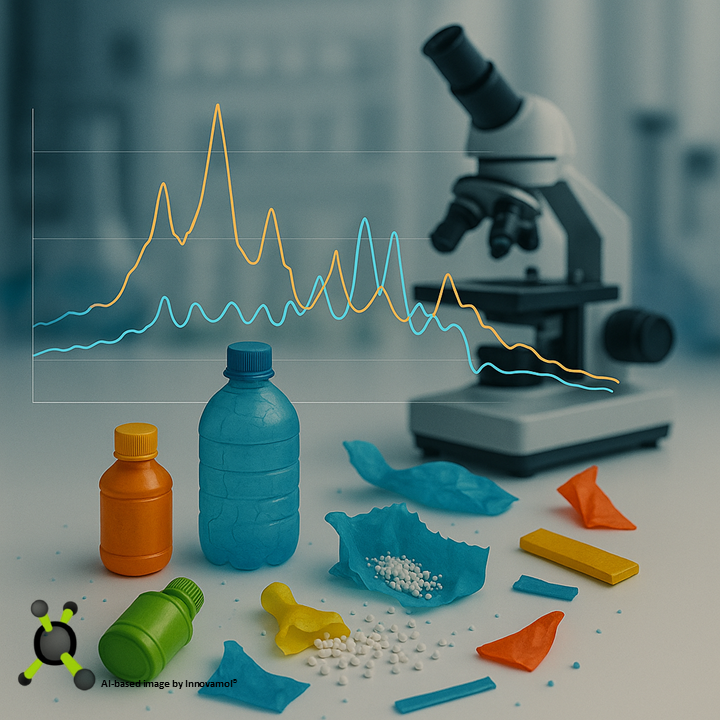In a previous Innovablog article, we already discussed the impact on human health on micro- and nanoplastics and some of the difficulties related to their detection, since they are heterogeneous and in complex matrices. Indeed, micro- and nanoplastics are everywhere, but proving it in a laboratory setting is anything but straightforward. While regulatory conversations often focus on the presence of plastic particles in food, water, and air, scientists are still facing major obstacles in simply detecting, identifying, and quantifying these particles—especially the nanoscale ones. While some tools are already available, they are not yet sufficiently fast, robust, or standardised—particularly when it comes to defining what exactly should be detected and managing the complexity of real-world matrices.
One of the first issue is the “invisibility”. Nanoplastics are smaller than the wavelength of visible light, making them undetectable with standard optical microscopy. Even larger microplastics can be hard to distinguish from either organic or mineral particles, or even natural fibres under a microscope. And since many of these particles are irregular, partially degraded, or contaminated, automated detection algorithms often fail to identify them consistently.
Another layer of complexity arises from the broad array of analytical techniques required to selectively detect and characterise micro- and nanoplastics. These range from microscopy methods used to observe particle size and morphology, to spectroscopic and thermal approaches that reveal chemical composition and polymer identity. Techniques such as FT-IR and Raman spectroscopy are commonly employed to identify plastics based on their molecular signatures, yet they are susceptible to interference from water, fluorescence, or background signals, and their reliability can vary depending on particle size and surface condition. Microscopy, while relatively accessible, depends heavily on user expertise and careful sample preparation, with a high risk of misidentifying or miscounting particles in complex environmental samples. Mass spectrometry and thermal decomposition methods offer more detailed compositional information but are often destructive and technically demanding. Other tools, including nuclear magnetic resonance (NMR), high-performance liquid chromatography (HPLC), and flow cytometry, can complement detection efforts but are not yet fully scalable. The diversity of these techniques—with their differing sensitivities, sample constraints, and limitations—underscores the difficulty of establishing a harmonised approach. To overcome these trade-offs, the integration of multiple analytical methods with advanced data processing techniques, such as machine learning, may be essential for developing more reliable, high-throughput detection systems.
In addition, environmental complexity adds yet another layer of difficulty. In air, water, or soil, plastics coexist with an enormous variety of natural and synthetic particles. Separating them out often requires digestion, filtration, or density separation steps that can alter or destroy some of the microplastics. For nanoplastics, which behave more like colloids than solids, there is no universally accepted isolation method. Their low mass, tendency to aggregate and to form biofilms which are different depending on the fragmentation degree, make them elusive.
Taken together, this indicate that global monitoring data remain fragmented and often not comparable. Laboratories adopt different analytical techniques, focus on different size ranges, and apply varying thresholds for detection and identification. this lack of harmonisation is not solely due to methodological divergence—it also reflects underlying differences in investigative priorities. Some laboratories prioritise chemical composition, while others focus on particle size or shape, depending on their assumptions about what features are most relevant to human or environmental health. This divergence is further compounded by the fact that it is still unclear which specific characteristics of micro- and nanoparticles—such as size, shape, or material—are most harmful to humans. . As a result, this lack of comparability hampers progress across the board, from understanding exposure routes to designing effective and standardized regulatory frameworks.
Despite years of effort, we are still in the phase of building reliable toolboxes. As mentioned, some tools are fast but not accurate enough while others more reliable but not scalable. Until these trade-offs are resolved and standardised, even the basic question “how much plastic is out there?” remains hard to answer. Detection is a foundation, not just a technical challenge. For this reason, the broader framework of nano- and microplastic science continues to evolve and consolidate, as it seeks stronger methodological and analytical foundations.
“Every great advance in science has issued from a new audacity of imagination” – John Dewey

